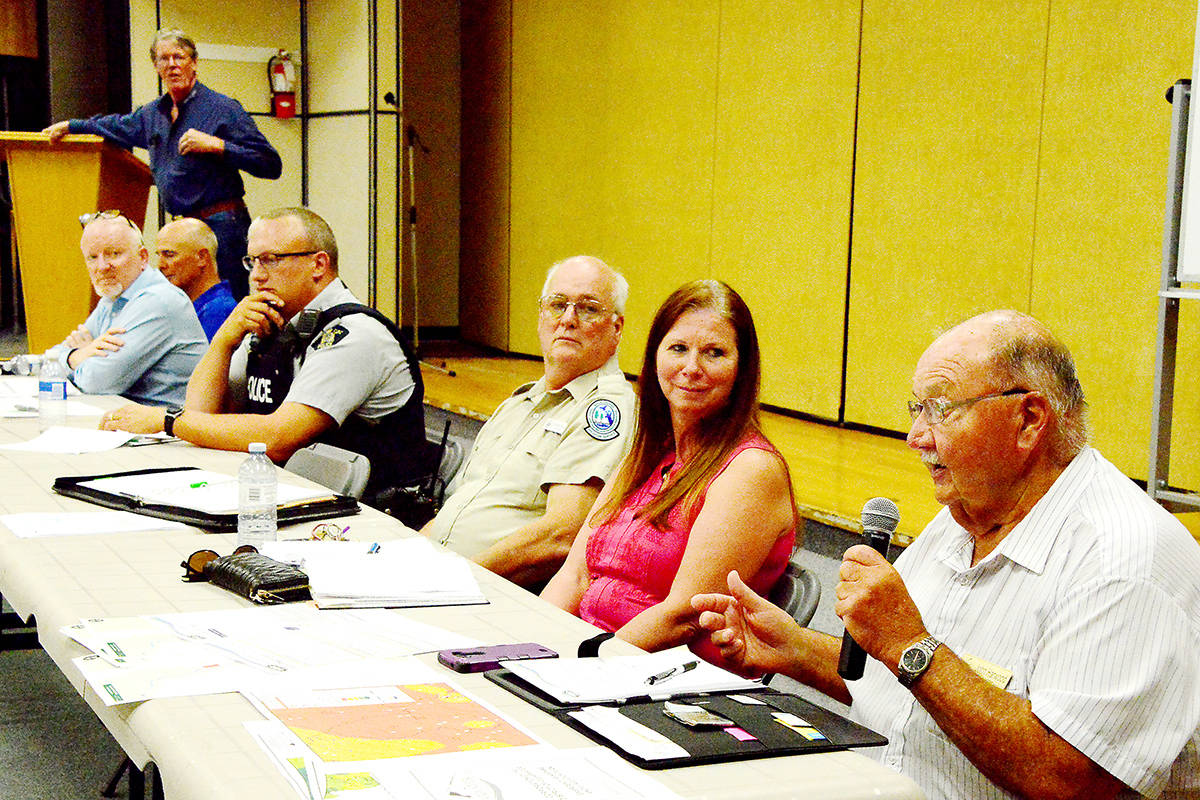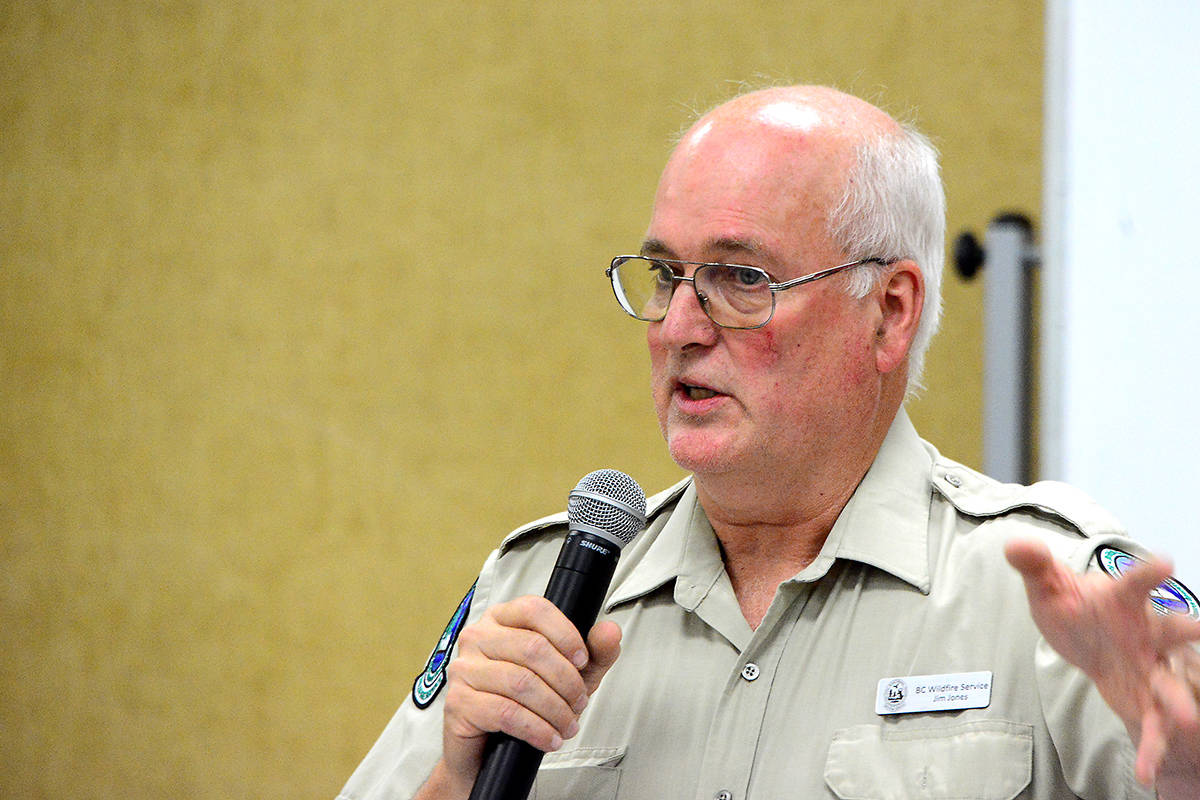The fire situation has grown quieter but could pick up again this weekend when a cold front is forecast to pass over much of the province.
That seemed to be the most important message presented during a wildfire information meeting held Thursday evening at Clearwater Secondary School.
If you’ve not already packed, now is the time to get ready.
If there is an evacuation alert or an evacuation order, then police, search and rescue volunteers, or other people with proper authority will go door-to-door to let residents know.
An evacuation alert means get ready to leave. An evacuation order means it’s time to go.
In anticipation of a potential crisis, whether this weekend or later, the province is expanding its plans for evacuees, Steve Newton, the regional manager for Emergency Management BC, told the meeting.
“This going to be a record year in terms of fire behavior,” he predicted.
Newton felt that the fire season will affect tens of thousands of people before it ends, which he said might not be for another 60 days or more.
Expanded evacuation plans include not just making arrangements to accommodate people in Kamloops and Kelowna, but also the Lower Mainland, Alberta and Washington State.
If an evacuation is ordered, where Clearwater and area residents should go would depend on the situation.
If the highway to the south is blocked, for example, local residents might be directed to go north to Prince George or even Alberta.
Primary responsibility for disaster management lays with local governments such as District of Clearwater and Thompson-Nicola Regional District. Emergency Management BC’s role is to provide them with support, as well as to non-governmental organizations and other agencies involved.
TNRD prepares for more evacuations
Thompson-Nicola Regional District recently acquired several hundred cots for evacuees in Kamloops, reported Sukh Gill, TNRD chief administrative officer.
He noted that the evacuees from 100 Mile House were directed towards Prince George but 200 to 300 went to Kamloops. The city also received people from Williams Lake.
If people do evacuate, it is important that they register both with Emergency Social Services and with the Red Cross.
Registering with ESS is necessary to receive immediate help.
Registering with the Red Cross will help evacuees receive other help such as a part of the $100 million that Premier Christy Clark recently promised (and that Premier-designate John Horgan has confirmed) for evacuees.
Registering with the Red Cross also assists the government keep track of who has gone where, and with family reunification.
Mayor make report
“If Clearwater evacuates, I will be the one signing the order,” said Mayor John Harwood.
For people outside the municipality, such as Vavenby or Blue River, the order would be signed by the TNRD.
Harwood noted that local governments and other agencies have held regular table-top exercises to prepare for major evacuations and similar events.
District of Clearwater meets on a daily basis with government officials to keep abreast of developments, the mayor said.
The district has discussed with BC Hydro about contingency plans for if fire cuts the power-line up the valley as happened in 2003. The provincial utility is prepared to bring in a massive generator to keep the essential services operating, he said, but it would take a couple of days.
Harwood said that the district has lobbied hard to keep the Clearwater Fire Zone office here in Clearwater. That will continue to be a priority after the present situation, he said.
The closure of Wells Gray Park is hurting the local tourist industry and will continue to do so for some time, the mayor felt.
However, closing the park temporarily would cause far less damage to its reputation than would be a tragedy such as happened recently in Portugal in which over 60 people were trapped and killed by wildfire.
Wells Gray Park receives about 3,000 visitors per day in the summer.
He noted that it took decades for the park’s reputation to get over the murder of six people in the early 1980s, even though it took place outside the park boundaries.
There have been reports in Europe that Wells Gray Park has burned, he said.
Harwood said that there are now about 200 people working to control wildfires in the Little Fort to Clearwater area, plus a growing contingent of RCMP.
Local loggers working on fire
The ratio of those working on the Little Fort wildfires is about 50/50 government crews to contractors, said forest protection officer Jim Jones.
“I want to be sure you realize it is not a one person effort. It is a team effort that includes people who live on the land,” he said. “Everyone plays a part in this.”
The fires northeast of Little Fort on Boulder Mountain and Queen Bess Ridge have a combined area of about 1,300 hectares, he reported.
The Thuya Lake fire to the southwest of Little Fort is about 400 hectares.
A fire in the headwaters of Lemeiux Creek near Mann Lake was discovered on Wednesday. It has grown to 10 hectares. Resources used to attack it include air tankers, heavy equipment and four Initial Attack crews from Alberta.
The major fires across the province are ranked in priority, he said. The Little Fort fires are number seven out of 14. Number one is the fires in the Cariboo, while Princeton is number two.
Logging continues but all high risk operations have been stopped, Jones said.
Lower risk operations, such as loading and hauling, can continue, at least for now.
“There could come a point where we will consider a total closure,” the forest protection officer said.
Workers with a sprinkler system deployed to protect property north of Dunn Lake were actually the first firefighters on the ground, he said.
The system plus a contractor to operate it came from the Office of the Fire Commissioner.
More sprinkler systems are on order from across Canada.
Firefighters photographed gathered around a campfire on Tuesday evening next to Adams Lake have been removed from the fire, Jones said.
The incident, which created a stir on social media, is under investigation.
All of B.C., except for Haida Gwai and a narrow strip along the west coast of Vancouver Island, is presently under a campfire ban.
Traffic patrols increase
Police resources across the province are being re-deployed to help deal with the crisis, reported Cpl. Darren Underhill of Clearwater RCMP.
Highway 5 is now the major corridor to the northern part of the province, resulting in a huge increase in traffic.
Extra patrols are being added but it is difficult to achieve adequate coverage, due to the distances involved.
Regular police operations are continuing, he emphasized.
Photos put up on social media of people throwing cigarette butts out of a car window will be investigated, he said.
Volunteer fire departments help out
Blackpool Fire Department continues to do regular patrols south towards Little Fort while Clearwater Fire Department is doing the same along Dunn Lake Road, reported Blackpool deputy fire chief Mike Savage.
A motor vehicle accident causing a wildfire would just add to an already difficult situation.
“Our goal is to hit it hard and hit it fast,” Savage said.
He noted that Kinder Morgan has done a fantastic job protecting its pumping facility at Blackpool and also helped control a fire in Little Fort.
The deputy chief thanked the many businesses that have released their employees so they could work as volunteers.
He said the department has been working with local farmers to set up sprinkler lines to establish “humidity domes” to protect structures.
Savage encouraged local residents to get a copy of the FireSmart pamphlet and take steps to protect their property from fire.
Cleaning out “gutter clutter” and removing drier lint are two simple steps that can make a big difference.
Clean air is important
Interior Health has information on how to protect yourself from poor air and water quality during a forest fire, as well as tips for dealing with stress, said Don Ferguson, IHA emergency and enforcement manager.
Go to www.interiorhealth.ca > YourEnvironment > Emergency Preparedness > Forest Fires.
The regional health agency typically evacuates its hospitals while they are at the alert phase and does not wait for an order, he said.
If possible, an emergency department will be maintained even if the hospital is evacuated.
TNRD has begun posting daily bulletins on its website, said information officer Debbie Sell. The address is http://tnrd.ca/content/general-information
A resilience centre to give help to those evacuated has been set up in Kamloops as well.
Thursday evening’s meeting was led by John Ranta, the TNRD chair and mayor of Cache Creek.
It was a follow-up on a meeting held Monday, July 10 that was directed more towards evacuees and also led by Ranta.
“Evacuation can happen at any time – be prepared to get a knock at any time,” Ranta said.


